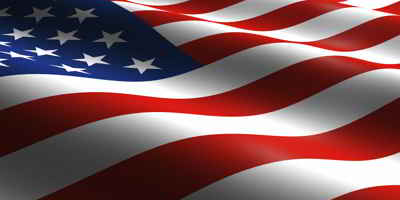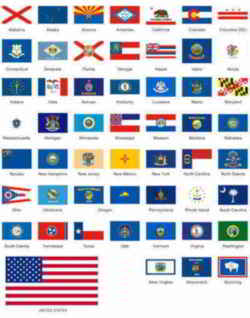

Virginia Symbols
Virginia State
Flag
Adopted in 1861.
The Seal of the Commonwealth of Virginia is the official seal of the Commonwealth of Virginia, a U.S. state. The flag of Virginia consists of the obverse of the seal against a blue background. The current version of the flag was adopted at the beginning of the American Civil War in 1861. The flag may be decorated with a white fringe along the fly.
The Virginia State Flag
In May 1776 the Virginia colony declared its independence from Great Britain. On July 1, 1776, a committee of four was appointed to make a proper seal for the Commonwealth of Virginia. The four men were Richard Henry Lee, George Mason, George Wythe, and Robert Carter Nicholas. Four days later the committee's report for a design of the seal was read, and George Mason presented it to the Virginia government. It was voted on and approved that same day. It is not known for certain which members of the committee were chiefly responsible for the design of the seal, but it is generally believed to be principally the work of George Wythe.
The seal makers did not want a design which in any way resembled the style of coats-of-arms used in Britain. Because of the strong admiration for the Roman Republic felt by the Virginia leaders, the design of the new seal was taken from the mythology of Ancient Rome. They also chose a two-sided design, as shown above.
Because Virginia was the first part of the country to be settled by English colonists, the state flag proudly represents Virginia's love of freedom. A deep blue field contains the seal of Virginia with the Latin motto " Sic Semper Tyrannis" - "Thus Always to Tyrants". Adopted in 1776. The two figures are acting out the meaning of the motto. Both are dressed as warriors. The woman, Virtue, represents Virginia. The man holding a scourge and chain shows that he is a tyrant. His fallen crown is nearby.
On April 30, 1861, a flag very similar to the current flag was adopted when Ordinance No. 30 was embraced by the Virginia Convention of 1861 - The Secession Convention. This ordinance was ratified by a vote of the electorate in May.
As for the Flag of the Commonwealth adopted in 1861, some minor changes were made in the first half of the 20th century.
- In 1930 the white fringe was added to the fly.
- In 1931 the "ornamental border" of the seal was more precisely defined as a wreath of Virginia creeper.
- On March 16, 1949, exact colors were assigned to the various design elements.
Salute to the flag
The General Assembly of Virginia adopted an official salute to the flag of Virginia in 1954. It reads:
" I salute the flag of Virginia,
with reverence and patriotic devotion
to the 'Mother of States and Statesmen,'
which it represents- the 'Old Dominion,'
where liberty and independence were born."
No. 33 - An ORDINANCE to establish a Flag for this Commonwealth
Be it ordained by the convention of the commonwealth of Virginia, that
the flag of this commonwealth shall hereafter be made of bunting, which shall be a deep blue
field with a circle of white in the centre, upon which shall be painted or embroidered, to
show on both sides alike, the coat of arms of the state, as described by the convention of
seventeen hundred and seventy-six, for one side of the seal of state, to wit:
"Virtus, the genius of the commonwealth, dressed like an Amazon, resting on a spear with one hand,
and holding a sword in other, and treading on tyranny, represented by a man prostrate, a crown
fallen from his head, a broken chain in his left hand and a scourge in his right. In the exergon
the word Virginia over the head of Virtus, and underneath the words "Sic Semper Tyrannis."
This flag shall be known and respected as the flag of Virginia.
The governor shall regulate the size and dimensions of the flag proper for forts, arsenals
and public buildings, for ships of war and merchant marine, for troops in the field, respectively,
and for any other purpose, according to his discretion; which regulations shall be published
and proclaimed by him as occasion may require.
This ordinance shall take effect from its passage.
Virginia Flag Law
Code of Virginia, Title 1, Chapter 5.
Title 1 - GENERAL PROVISIONS.
Chapter 5 - Emblems
§ 1-506. Flag of the Commonwealth.
The flag of the Commonwealth shall be a deep blue field, with a circular white centre of the
same material. Upon this circle shall be painted or embroidered, to show on both sides alike,
the coat of arms of the Commonwealth, as described in § 1-500 for the obverse of the great
seal of the Commonwealth; and there may be a white fringe on the outer edge, furthest from
the flagstaff. This shall be known and respected as the flag of the Commonwealth.
(Code 1950, § 7-32; 1966, c. 102, § 7.1-32; 2005, c. 839.)
§ 1-507. Governor to prescribe size of flag.
The Governor shall regulate the size and dimensions of the flag proper for forts, arsenals
and public buildings, for ships-of-war and merchant marine, for troops in the field, respectively,
and for any other purpose, according to his discretion by proclamation.
(Code 1950, § 7-33; 1966, c. 102, § 7.1-33; 2005, c. 839.)
§ 1-508. Director of General Services to have available flags of the Commonwealth for
sale.
The Director of the Department of General Services shall have available at all times flags
of the Commonwealth, to be offered for sale to the public in such manner as the Director may
determine.
Such flags shall be of good quality, shall conform to the specifications prescribed in § 1-506,
and shall be offered in the various sizes prescribed by the Governor pursuant to § 1-507.
The prices to be charged for such flags shall be at cost as determined by the Director.
(Code 1950, § 7-33.1; 1958, c. 553; 1960, c. 347; 1966, c. 102, § 7.1-34; 2005, c. 839.)
§ 1-509. When flag to be suspended over Capitol.
During the sessions of either house of the General Assembly the flag of the Commonwealth shall
be kept raised over the respective chambers of the Capitol, or other place of session, if practicable,
as directed by the Director of the Department of General Services and the Chief of the Virginia
Capitol Police in consultation with the Clerk of the House of Delegates and the Clerk of the
Senate.
(Code 1950, § 7-34; 1966, c. 102, § 7.1-35; 1970, c. 561; 2005, c. 839.)

The Flags of the US.





